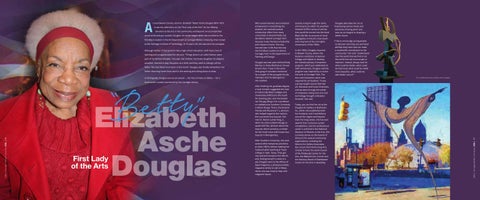is warmly referred to as the “First Lady of the Arts” for her lifelong devotion to the arts in her community and beyond. An accomplished visual artist and jazz vocalist, Douglas’ art career began when she enrolled as the first Black student in the Art Department at Carnegie Mellon University, then known as the Carnegie Institute of Technology. At 16 years old, she was also the youngest. Although neither of her parents had a high school education, both had a love of learning and an appreciation for the arts. “Things done in an artful fashion were part of my family’s lifestyle,” she said. Her mother, the foster daughter of a Baptist preacher, learned to play the piano as a child, and they used to jokingly call her father “the best Black Irish tenor in the world.” Douglas also fondly remembers her father returning home from work in the evening and sitting down to draw. In third grade, Douglas won an art award — the first of many to follow — for a
[ Art ] Carnegie Mellon University CFA | 26
book poster contest sponsored by the Carnegie Library.
Elizabeth Asche Douglas
First Lady of the Arts
With varied interests and scholastic achievement in everything she studied, she received several scholarship offers from many universities in diverse fields, but decided to attend Carnegie Tech because it was the best scholarship and closest to home. She only learned later in life that she was the first Black student to attend Carnegie Tech in the Department of Painting and Design. Douglas was two years behind Andy Warhol, or Andy Warhola as he was known then. “I was in the same little gang of outsiders mentored by a couple of the youngest faculty members that he belonged to,” she recalled. After finishing her graduate degree, a local minister suggested she look at Historically Black Colleges and Universities (HBCUs) in the South for teaching jobs, and she landed her first gig filling in for a professor on sabbatical at Southern University in Baton Rouge. There, she became friends with Reverend T. J. Jemison, who helped organize the nation’s first successful bus boycott. She met Dr. Martin Luther King, Jr., when he came to Baton Rouge to speak with Rev. Jemison about the boycott, which served as a model for the much more well-known bus boycott in Montgomery. After Southern University, she took several other temporary positions at other HBCUs before meeting her husband while teaching at Texas College in Tyler, Texas. They got married and moved to Fort Worth, and, finding herself in need of a job, Douglas went to the offices of Sepia magazine, a photojournalistic magazine similar to Life or Ebony, where she was hired to help with magazine layout.
Quickly rising through the ranks, she became an editor for Jonathan Howard Griffin’s series of articles that would be turned into the book Black Like Me, an account of racial segregation in the Jim Crow South and a key text of the civil rights movements of the 1960s. In the 1960s, Douglas returned to Beaver County, where she became a professor at Geneva College and helped to develop the Interdisciplinary Humanities program, which just celebrated its 50th anniversary. Douglas said the program was inspired by a course she took at Carnegie Tech, The Arts and Civilization, which was required for all students. “It was a group-taught course that had art, literature and music historians, and we went through the whole of civilization noting how arts and technology brought civilization forward,” she said. Today, you can find her art at the Douglas Art Gallery in Rochester, Pa., which she established with her husband, and in exhibitions around the region and beyond. Over her long career, she has won awards from numerous juried competitions, and her professional career is archived in the National Museum of Women in the Arts. She currently serves on the boards of directors for several community organizations, including the Merrick Art Gallery Associates, the Lincoln Park Performing Arts Charter School, the Guild Council of the Pittsburgh Center for the Arts, the Midland Arts Council and the Advisory Board of Sweetwater Center for the Arts in Sewickley.
Douglas describes her art as “expressing various levels and elements of being alive” and sees art as integral to shaping a better future. “I like to encourage young people to discover who they are and what abilities they have that can make a worthwhile contribution to the community,” she said. “Understand that the world that we find is not the world that we must accept or maintain. Instead, always look for what could be better, what could be improved, what could be made more beautiful, what could we take better care of.” The multifaceted works of Betty Asche Douglas
[ Art ] Carnegie Mellon University CFA | 27
round Beaver County, alumna Elizabeth “Betty” Asche Douglas (BFA 1951)







